Physical Address
304 North Cardinal St.
Dorchester Center, MA 02124
A hernia is a protrusion of an organ or structure into an opening or pouch. Abdominal wall hernias protrude through the muscular and fascial walls of the abdomen and have 2 parts: (1) the orifice or defect in the aponeurotic wall of the abdomen, and (2) the hernia sac, which consists of peritoneum and abdominal, contents. Abdominal wall hernias are external if the sac protrudes through the abdominal wall or interparietal if the sac is contained within the abdominal wall. Internal hernias are contained within the abdominal cavity and do not always have a hernia sac.
Hernias are reducible when the protruding contents can be returned to the abdomen and irreducible or incarcerated when they cannot. A hernia is strangulated when the vascular supply of the protruding organ is compromised, and as a consequence the organ becomes ischemic or necrotic. An incarcerated hernia is generally repaired because there is danger of strangulation, which can result in the loss of bowel. Because it can be difficult to determine whether a hernia is incarcerated or strangulated, incarcerated hernias are considered urgent and treated with surgical intervention. Another type of hernia is a Richter hernia , where only one side of the bowel (most often the antimesenteric side) protrudes through the hernia orifice. As opposed to other hernias, strangulation may occur in a Richter hernia without intestinal obstruction, making this type of hernia a diagnostic challenge.
There are 3 main types of diaphragmatic hernias: hiatal and paraesophageal hernias (both involve the hiatus), congenital hernias, and traumatic hernias.
The most common diaphragmatic hernias are sliding hernias of the stomach through the esophageal hiatus, which include hiatal and paraesophageal hernias. Technically, all these hernias are hiatal hernias because they pass through the esophageal hiatus of the diaphragm. These are centrally located hernias.
Sliding hiatal hernias (type I) occur when the gastroesophageal junction and some portion of the stomach are displaced above the diaphragm, but the orientation of the stomach axis is unchanged. The frequency of sliding hiatal hernias increases with age. The phrenoesophageal membrane anchors the gastroesophageal junction to the diaphragm (see Chapters 43 and 46 ). Hiatal hernias may be caused by age-related deterioration of this membrane, combined with normal positive intra-abdominal pressure and traction of the esophagus on the stomach as the esophagus shortens during swallowing.
Paraesophageal hernias (type II) occur when the stomach protrudes through the esophageal hiatus alongside the esophagus ( Fig. 27.1 A ). The gastroesophageal junction remains in a normal position at the level of the diaphragm, because there is preservation of the posterior phrenoesophageal ligament and normal anchoring of the gastroesophageal junction, and only the stomach moves proximally. The entire stomach can pass into the chest (see Fig. 27.1 B ). Most paraesophageal hernias contain a sliding hiatal component in addition to the paraesophageal component and are thus mixed diaphragmatic hernias (type III [see Fig. 27.1 C ]). With a paraesophageal hernia, other intra-abdominal structures (e.g., omentum, colon, spleen) may also herniate (type IV). A barium study is often obtained to diagnose these defects. However, cross sectional imaging with CT scan will be the test of choice to document a type IV defect, as the barium study may not reveal adjacent colon or pancreas through the hiatus. When diagnosing a hiatal or paraesophageal hernia, important questions for the radiologist to address include: (1) Does the gastroesophageal junction lie at or above the hiatus? (2) Does the stomach or any other visceral structure lie above the gastroesophageal junction? For example, if the gastroesophageal junction is above the hiatus and there is stomach above it, the patient has a type III (mixed) hernia.
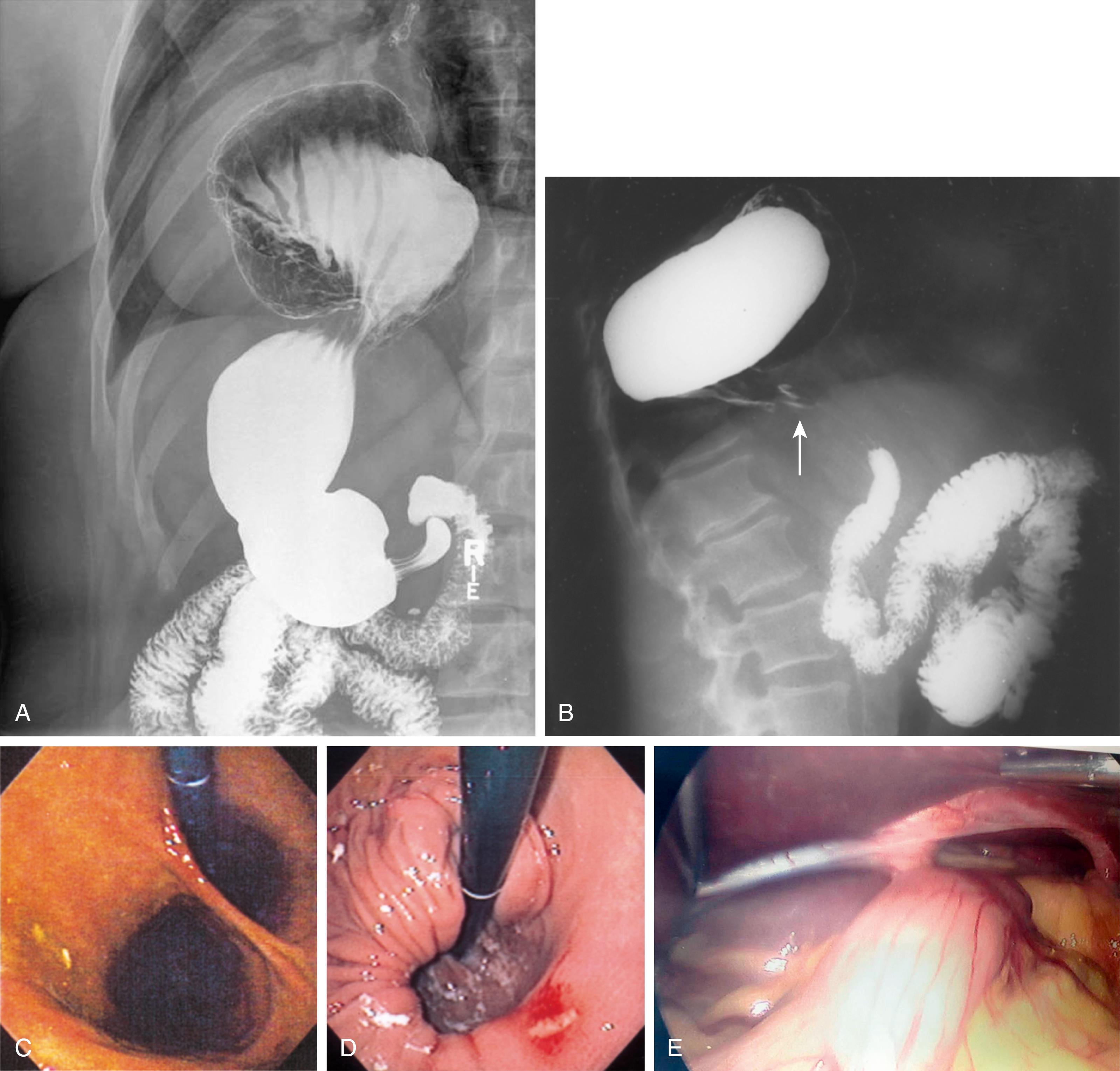
Estimates of the prevalence of hiatal hernia vary widely, ranging from 14% to 84% of patients examined, depending on the patient population, method of diagnosis, and symptoms present. In general, hiatal hernias are more frequent in patients with GERD. About 90% to 95% of hiatal hernias found by radiograph are sliding (type I) hernias; the remainder are paraesophageal hernias. Most sliding hiatal hernias are small and of little clinical significance. Patients with symptomatic paraesophageal hernias are most often middle-aged to older adults.
Many patients with small simple sliding hiatal hernias are asymptomatic. The main clinical significance of the sliding hiatal hernia is its contribution to gastroesophageal reflux (see Chapter 44 ). In addition to heartburn and regurgitation, patients with large sliding hiatal hernias may complain of dysphagia or discomfort in the chest or upper abdomen. With chest radiography, a hiatal hernia may be noted as a soft tissue density or an air-fluid level in the retrocardiac area. Hiatal hernias are sometimes diagnosed on UGI barium studies. CT can demonstrate the proximal stomach above the diaphragmatic hiatus. At endoscopy, the gastroesophageal junction is noted to be proximal to the impression of the diaphragm.
Patients with paraesophageal or mixed hiatal hernias are rarely completely asymptomatic if closely questioned. Many patients with paraesophageal hernias have gastroesophageal reflux, particularly those with larger paraesophageal hernias. Other symptoms include dysphagia, chest pain, vague postprandial discomfort, and shortness of breath, and some patients will have iron deficiency anemia due to chronic GI blood loss.
A paraesophageal or mixed hiatal hernia may be seen on a chest radiograph as an abnormal soft tissue density (often with a gas bubble) in the mediastinum or left chest. UGI radiography is the best diagnostic study (see Fig. 27.1 A ). CT scanning can demonstrate that part of the stomach is in the chest. Differences between UGI radiography and CT scan can sometimes be seen, as the latter is performed in the supine position where the stomach may migrate further into the chest. Paraesophageal hernias are usually obvious on upper endoscopy (see Fig. 27.1B ), but the paraesophageal component of a large mixed hernia may be missed.
Cameron lesions or linear erosions may develop in patients with sliding hiatal hernias, particularly large hernias (see Chapter 20 ). These mucosal lesions are usually found on the lesser curve of the stomach at the level of the diaphragmatic hiatus (see Fig. 27.1 D ). This is the location of the rigid anterior margin of the hiatus formed by the central tendon of the diaphragm. Mechanical trauma, ischemia, irritation by pills, and peptic injury have been proposed as the cause of these lesions. The prevalence of Cameron lesions in patients with hiatal hernias who undergo endoscopy has been reported to be about 5%, with the highest prevalence in the largest hernias, with rates of approximately 30% in paraesophageal hernias referred for surgical repair. Cameron lesions may cause acute or chronic UGI bleeding with a poor response to acid suppression therapy. Iron deficiency anemia due to chronic bleeding is seen in 30% to 40% of patients with paraesophageal hernia. The presence of Cameron lesion(s) and occult GI bleeding is one factor that will influence the surgeon’s decision to repair a paraesophageal hernia that is otherwise apparently asymptomatic.
Gastric volvulus is a life-threatening complication of paraesophageal hernia. Symptoms include acute abdominal pain and retching, and it can progress rapidly to a surgical emergency (see ). With UGI radiography or CT, lack of filling the gastric lumen with contrast or gastric wall thickening with pneumatosis can increase suspicion for a volvulus and associated gastric necrosis. The diagnosis of gastric volvulus is mostly clinical and the clinician must have a low threshold to entertain this diagnosis in a patient with a known paraesophageal hernia and new symptoms. Endoscopy may be difficult if the hernia is associated with gastric volvulus, and reaching the pylorus may be a challenge due to positioning of the stomach.
Simple sliding hiatal hernias do not require treatment, unless symptomatic from reflux (see Chapter 46 ). Patients with symptomatic giant sliding hiatal hernias, paraesophageal, or mixed hernias should be offered surgery. When closely questioned, most patients with type II, III, or IV hernias will have symptoms. In the past, all paraesophageal hernias were thought to be a surgical emergency, but it is now clear that the risk of progression to gastric necrosis is lower than initially believed. Elective repair of paraesophageal hernias is more frequently offered to symptomatic patients, although some experts suggest that surgery should be offered to all patients with paraesophageal hernias because of the risk of future complications. In general, a selective approach to patients with large paraesophageal hernias is warranted; those with symptoms that may be due to the hernia should be considered for surgical intervention, depending on other comorbidities. A careful history is essential for determining the presence of symptoms. One should pay careful attention to chest pain and postprandial shortness of breath; these may be symptoms related to the paraesophageal hernia. Indeed, patients with pulmonary issues may benefit from having their paraesophageal hernias repaired to create room in the chest and decrease aspiration events.
The extent of the preoperative evaluation needed for paraesophageal hernia repair is controversial. Patients often have already had a barium esophagogram or other esophageal study that characterizes the paraesophageal hernia. Many surgeons recommend routine preoperative evaluation with esophageal manometry and ambulatory esophageal pH monitoring because of the high prevalence of associated gastroesophageal reflux and esophageal motility disorders, while others may forgo pH testing and use reflux symptoms as a guide for the type of repair chosen. The idea behind forgoing pH testing is that the result will not change the surgical management of the patient, who will receive hernia reduction and wrap of some kind anyway. Options for assessment of esophageal pH include 24-hour impedance/pH testing and 48-hour wireless capsule pH monitoring. The object of manometric evaluation is to determine whether the patient has a significant motility disorder (e.g., achalasia, aperistalsis) and what type of fundoplication is needed in patients with reflux symptoms (complete vs. partial wrap). However, esophageal manometry is challenging in these patients, and anatomic distortions can make it difficult to identify the lower esophageal sphincter, making this measurement unreliable. Patients with dysphagia should be studied to ensure that significantly abnormal motility is not present. Many surgeons routinely add a fundoplication to hernia repairs to prevent postoperative reflux esophagitis and to fix the stomach in the abdomen. However, in patients with motility disorders, the surgeon may elect to perform a loose anterior wrap (Dor fundoplication) or use a gastrostomy tube or gastropexy to fix the stomach intra-abdominally. The authors’ practice is to forgo motility and pH testing, as the preference is to perform an incomplete wrap of some kind and not a 360-degree wrap that is dependent on good motility. Addition of gastropexy may reduce the recurrence rate after hernia repair.
The principles of surgery for repair of hiatal or paraesophageal hernias include 4 main elements: (1) reduction of the hernia from the mediastinum or chest, with excision of the hernia sac; (2) reconstruction of the diaphragmatic hiatus, with simple posterior closure with or without bolstering with prosthetic mesh; (3) providing bulk at the hiatus to prevent prolapse into the chest with a fundoplication, which can lessen postoperative reflux; and (4) addition of a gastropexy or gastrostomy tube to provide an additional tacking mechanism for the stomach intra-abdominally. These elements can be accomplished minimally invasively (laparoscopically or robotically), or via open operation performed through the abdomen or chest. Most patients are approached minimally invasively through the abdomen, which leads to a shorter hospital stay, less postoperative pain, and an equivalent risk of recurrence (see Fig. 27.1 E ). Reduction of chronic paraesophageal hernias from the chest can be difficult and may be approached through a combined thoracoscopic and abdominal procedure. Injury to the lung can occur with vigorous traction; however, as the diaphragmatic defect is central (medial) rather than peripheral (lateral), as in a traumatic defect, intense lung adhesions are usually not present. Resection of the hernia sac can result in violation of the left chest, requiring chest tube placement. Reconstruction of the diaphragm can be performed by placing nonabsorbable sutures posterior to the esophagus. Use of prosthetic mesh has resulted in fewer recurrences in some studies. The use of mesh is still controversial as there has been no clear long-term results demonstrating a decreased risk of hernia recurrence. However, most surgeons are wary of using synthetic mesh close to the esophagus, and therefore “biological” products are favored. The shape of the mesh is also an area of controversy. Keyhole mesh can be used, in which the esophagus is completely encircled with mesh, with the concern being dysphagia in this situation. Alternatively, U-shaped mesh can be used, where the anterior portion is left open, therefore reinforcing only posteriorly (the major area of recurrence). Fixation of the stomach in the abdomen is usually achieved by using a fundoplication, which provides some bolstering effect at the hiatus to keep the stomach in the abdomen and can reduce postoperative gastroesophageal reflux. Additional use of gastropexy, with suturing of the stomach to the abdominal wall or gastrostomy tube placement for 2 weeks to allow the stomach to mature to the abdominal wall, may result in fewer recurrences. It is the authors’ preference to perform a Dor fundoplication, close the diaphragm with keyhole biological mesh, and place a temporary gastrostomy tube (as a pexy) in all patients with large paraesophageal hernias.
Patients with sliding hiatal or paraesophageal hernias may have shortening of the esophagus. This makes it difficult to restore the gastroesophageal junction below the diaphragm without tension, a key factor in decreasing recurrence. In such cases, an extra length of neoesophagus can be constructed from the proximal stomach (Collis-Nissen procedure). In this situation, a stapler is fired parallel to the axis of the esophagus along a bougie that is passed into the stomach, creating a lengthened esophagus. Alternatively, transmediastinal dissection of the esophagus for more than 5 cm into the chest will usually result in adequate intra-abdominal length of esophagus without the need for additional stapling. In the authors’ experience, if an adequate transmediastinal dissection is undertaken with excision of the hernia sac, esophageal lengthening is rarely needed. Potential surgical complications include esophageal and gastric perforation, pneumothorax, and liver laceration. Potential long-term complications may include dysphagia if the wrap is too tight or gastroesophageal reflux if the fundoplication breaks down or migrates into the chest. When examined closely, radiographic recurrence after paraesophageal hernia repair is 15% to 25%. However, the clinical impact of a recurrence may be minimal because most of these patients remain symptom free and do not require further treatment. The patient who develops both reflux and dysphagia after paraesophageal hernia repair should be evaluated for a symptomatic recurrence. This is best performed by a UGI barium study. Upper endoscopy can also be helpful and provide dynamic information. The retroflex view from the stomach will demonstrate the presence or absence of a paraesophageal hernia.
Recurrence is higher in obese patients and many will favor a Roux-en-Y gastric bypass (RYGB) procedure in those that have a BMI greater than 35kg/m 2 .
Congenital diaphragmatic hernias (CDHs) are rare but can have significant complications. Many are diagnosed at birth.
CDHs result from failure of fusion of the multiple developmental components of the diaphragm ( Fig. 27.2 ). Embryologically, the diaphragm is derived from the septum transversum, which separates the peritoneal and pericardial spaces, the mesentery of the esophagus, the pleuroperitoneal membranes, and muscle of the chest wall. Morgagni hernias form anteriorly at the sternocostal junctions of the diaphragm, and Bochdalek hernias form posterolaterally at the lumbocostal junctions of the diaphragm. Bochdalek hernias most commonly manifest immediately after birth and are commonly associated with pulmonary hypoplasia.
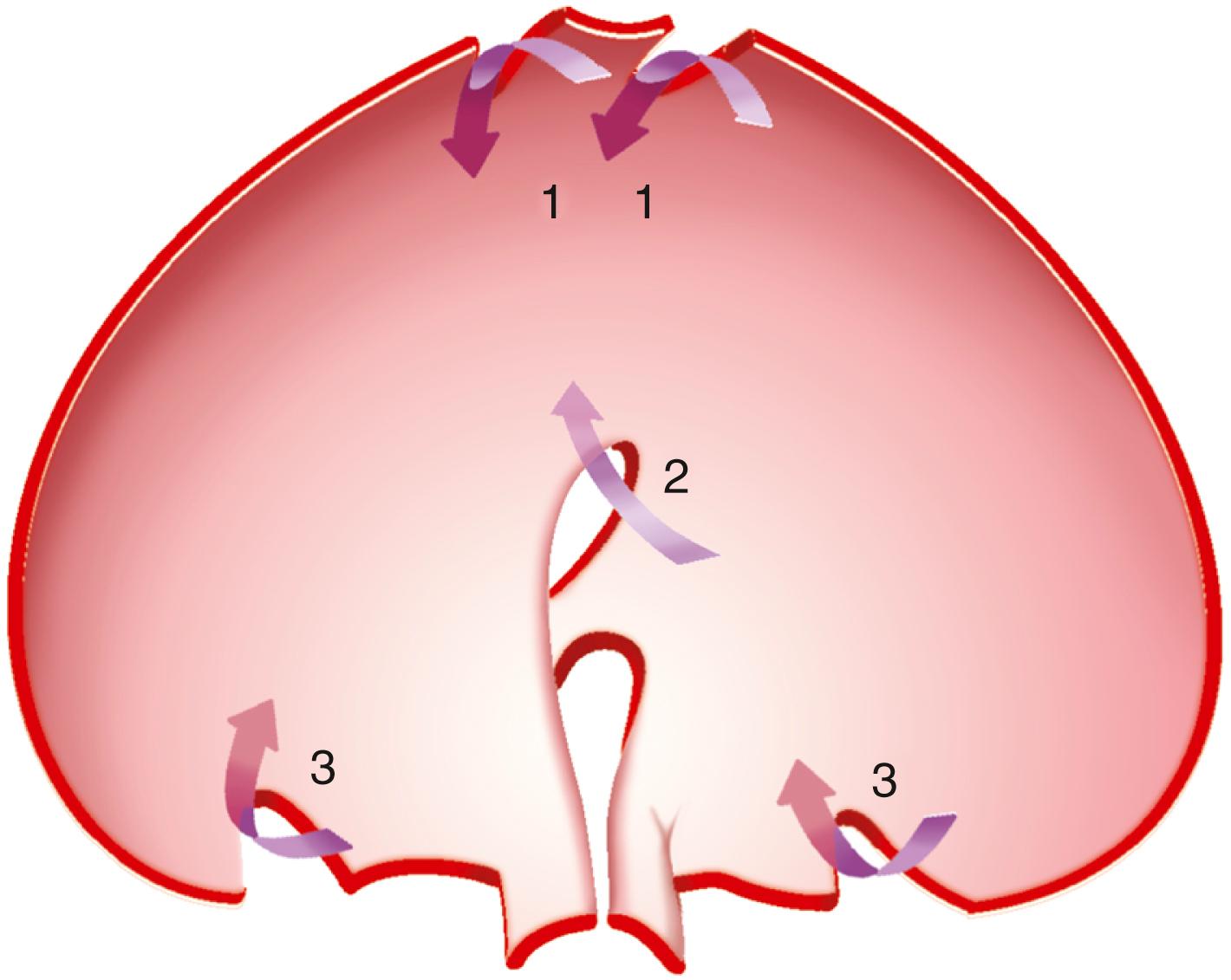
Congenital diaphragmatic hernias occur in about 1/2000 to 1/10,000 births, with some types seen more frequently in males. Hernias manifesting in neonates are most often Bochdalek hernias. With the routine use of prenatal ultrasound, CDHs can be discovered in the prenatal period. The presence of intra-abdominal contents in the chest during fetal development results in significant hypoplasia of the lung. It is the degree of pulmonary dysfunction, not the presence of the hernia per se, that determines the child’s prognosis. Prenatal measures are then taken to prepare for the pulmonary hypoplasia that invariably accompanies a large CDH. Only a few Bochdalek hernias are first discovered in adulthood. Bochdalek hernias occur on the left side in about 80% of cases ( Fig. 27.3 ). Right-sided Bochdalek hernias usually contain liver in the right chest. Morgagni hernias make up about 2% to 3% of surgically treated diaphragmatic hernias ( Fig. 27.4 ). Although thought to be congenital, they usually manifest in adults and occur on the right side in 80% to 90% of cases.
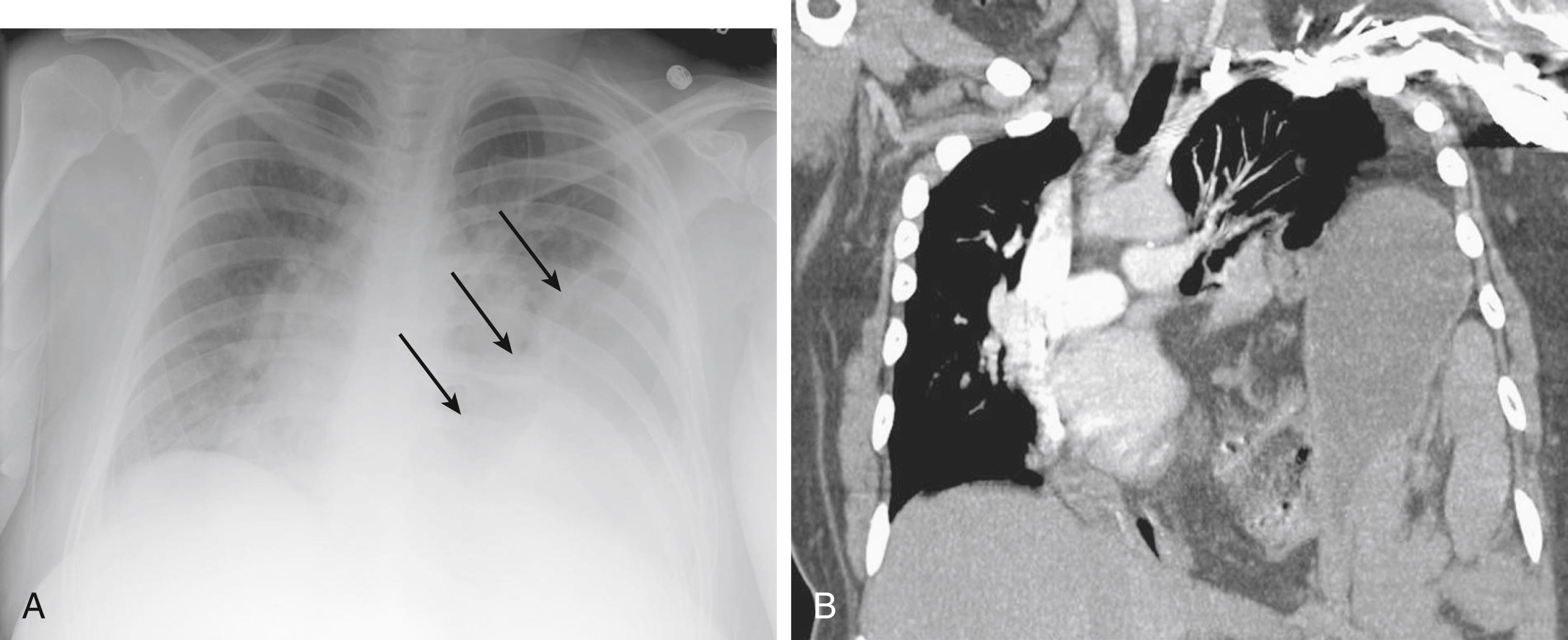
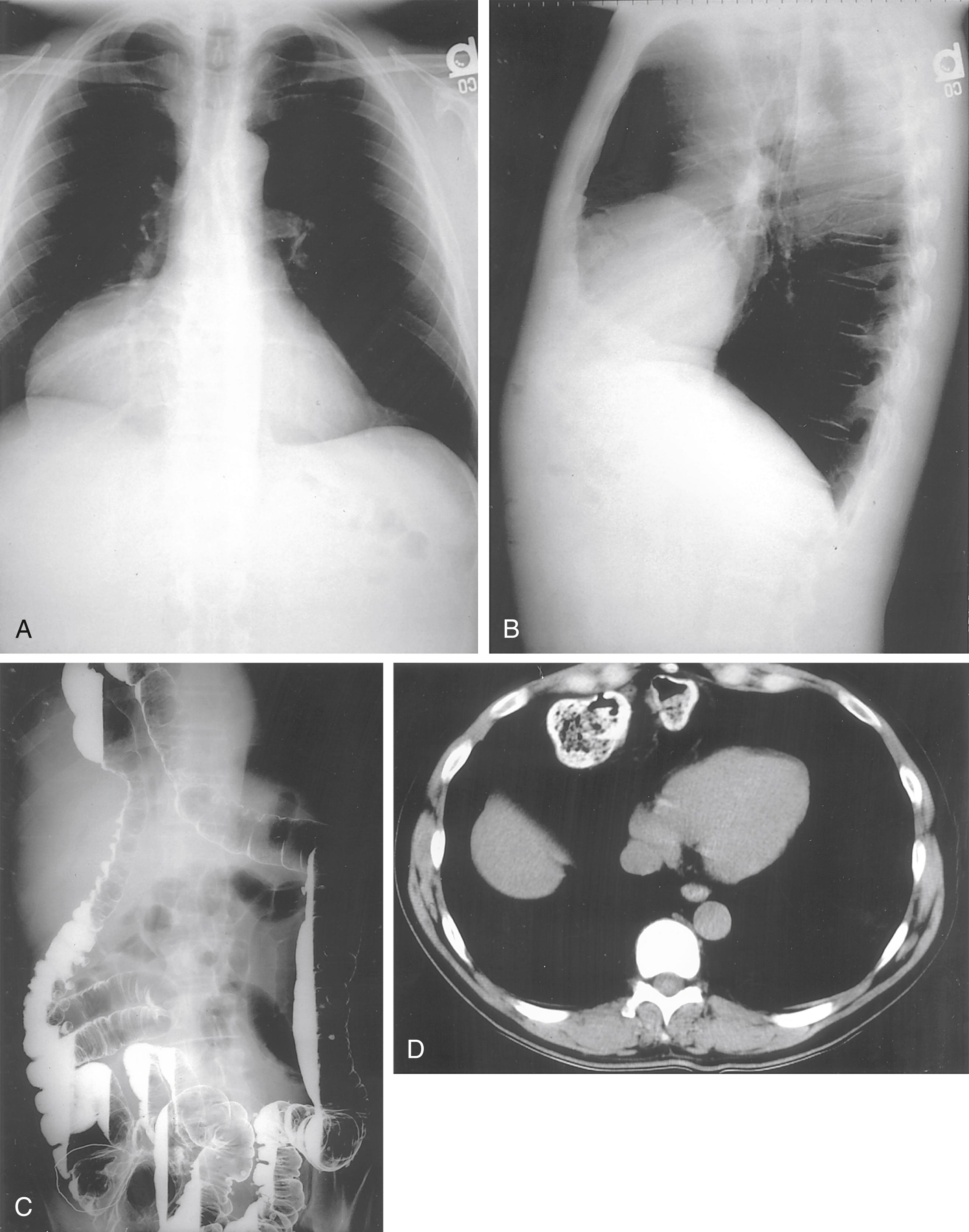
The clinical presentation of congenital diaphragmatic hernias varies greatly, from death in the neonatal period to an asymptomatic serendipitous finding in adults. Newborns with Bochdalek hernia have respiratory distress, absent breath sounds on one side of the chest, and a scaphoid abdomen. Serious chromosomal anomalies are found in 30% of cases, but in many cases the exact mutation (or mutations) cannot be identified. Pulmonary hypoplasia occurs on the side of the hernia, but some degree of hypoplasia may also occur in the contralateral lung. Pulmonary hypertension is common. The major causes of mortality in infants with Bochdalek hernias are respiratory failure and associated anomalies, which can include cardiac abnormalities and musculoskeletal defects. Most of these neonates are diagnosed in utero with routine use of prenatal ultrasound, which visualizes stomach or loops of bowel in the chest. The pregnancy is considered high risk when congenital diaphragmatic hernia is diagnosed in the prenatal period. These babies are delivered electively and preparations are made for immediate extracorporeal membrane oxygenation (ECMO).
In older children and adults, a Bochdalek hernia may manifest as an asymptomatic chest mass. The differential diagnosis includes mediastinal or pulmonary cyst or tumor, pleural effusion, or empyema. Symptoms, when present, can include pain, pulmonary symptoms, and obstructive symptoms and are due to herniation of the stomach, omentum, colon, or small bowel. About 30% of adult patients present with acute emergencies caused by strangulation, and gastric volvulus can occur. Other patients may have chronic intermittent symptoms, including chest discomfort, shortness of breath, dysphagia, nausea, vomiting, and constipation. The diagnosis may be suspected on a chest radiograph, particularly a lateral view. The key finding is a posterior chest mass, as the defect of Bochdalek is posterior. The diagnosis may be confirmed by barium UGI radiography (useful if only the stomach is involved), CT, or MRI.
Morgagni hernias are most likely to manifest in adult life. They may contain omentum, stomach, colon, or liver. Bowel sounds may be heard in the chest if bowel has herniated through the defect. As with Bochdalek hernias, the diagnosis is often made by chest radiography, particularly the lateral view, because Morgagni hernias are anterior, differentiating this hernia from a Bochdalek defect (see Fig. 27.4 ). The contents of the hernia can be confirmed with barium radiography or CT (see Fig. 27.3 A and B and Fig. 27.4 C and D ). The differential diagnosis is similar to that of Bochdalek hernias. Many patients have no symptoms or nonspecific symptoms such as chest discomfort, cough, dyspnea, and upper abdominal distress. Gastric, omental, or intestinal incarceration with obstruction and ischemia may cause acute symptoms.
For infants with Bochdalek hernias, intubation and mechanical ventilation are often needed at the time of delivery. ECMO is useful in some cases with cardiac dysfunction and pulmonary hypertension. Once the infant’s pulmonary issues have stabilized, surgical repair is performed, either open or laparoscopically, using a mesh prosthesis. Despite advances in critical care and surgical techniques, the mortality rate is still around 60%, although higher survival rates have been reported by some centers. The abdomen may not be able to tolerate the increased pressure when the intestinal contents are reduced, and therefore a gradual abdominal closure (“Silo” technique) can also be used.
Laparoscopic and thoracoscopic repair of Bochdalek hernias have been reported. Morgagni hernias have been repaired through the chest or abdomen, using open, thoracoscopic, and/or laparoscopic techniques. An abdominal laparoscopic approach is favored in small diaphragmatic hernias. One must be careful to note the inferior epigastric vessels that are present in the location of the Morgagni hernia. This anterior defect can be bridged with synthetic mesh. Larger Bochdalek defects require open approach with use of prosthetic mesh.
Traumatic diaphragmatic hernias are caused by blunt trauma such as motor vehicle accidents in about 75% of cases, and by penetrating trauma such as stab or gunshot wounds in the remainder. During blunt trauma, abrupt changes in intra-abdominal pressure may lead to large rents in the diaphragm. A huge impact is needed to cause a diaphragmatic injury. As such, associated injuries are commonly life threatening in the circumstance of a blunt diaphragmatic injury. Penetrating injuries often cause only small lacerations. Blunt trauma is more likely than penetrating trauma to eventually lead to herniation of abdominal contents into the chest, because the defect is usually larger. The right hemidiaphragm is somewhat protected by the liver during blunt trauma. Thus, in one series, 68% of diaphragmatic injuries from blunt trauma occurred on the left side, 24% on the right side, 1.5% were bilateral, 1% pericardial, and 5% unclassified. Diaphragmatic injury may not result in immediate herniation, but with time, normal relative negative intrathoracic pressure may lead to gradual enlargement of a small diaphragmatic defect and protrusion of abdominal contents through the defect, leading to a delayed diagnosis in about 15% of cases. Stomach, omentum, colon, small bowel, spleen, and even kidney may be found in a posttraumatic diaphragmatic hernia.
The incidence of posttraumatic diaphragmatic hernia is uncertain. Diaphragmatic injury occurs in about 5% of patients with multiple traumatic injuries who undergo laparotomy and was found in approximately 1% of patients in a large trauma database.
Posttraumatic diaphragmatic hernias may cause respiratory or abdominal symptoms. After serious trauma, rupture of the diaphragm is often masked by other injuries. Penetrating injuries between the fourth intercostal space and the umbilicus should raise the level of suspicion of a diaphragmatic injury. Respiratory or abdominal symptoms manifesting several days to weeks after injury should suggest the possibility of a missed diaphragmatic injury. The diaphragm must be closely inspected to detect injury at the time of exploratory laparotomy or laparoscopy, as these injuries can easily be missed. Careful examination of the chest radiograph or CT is important but is diagnostic in only 40% to 80% of cases, depending on the type of CT performed. The coronal and sagittal reconstructions can show the defect in the diaphragm. In patients on ventilatory support after trauma, positive intrathoracic pressure may prevent herniation through a diaphragmatic tear. However, on attempted ventilator weaning, herniation may occur, causing respiratory compromise. Symptoms may also manifest long after injury. Delays of more than 10 years have been reported. In such cases, the patient may not connect the acute illness with remote trauma. The treating physician should consider a traumatic cause when a diaphragmatic defect is not hiatal and is not located in the usual locations of congenital defects.
Acute diaphragmatic ruptures are most commonly approached from the abdomen during exploratory laparotomy or laparoscopy. Associated intra-abdominal injuries that can be life threatening must be ruled out in these cases. However, a chest approach can be undertaken. Diagnostic laparoscopy has been used in patients who are thought to have a high risk of diaphragmatic injury, but appear to have no other visceral injury (e.g., after a stab wound to the lower chest). Chronic posttraumatic diaphragmatic hernias are characterized by a lack of a peritoneal lining, or hernia sac. As such, these hernias are commonly associated with extensive adhesions to adjacent lung, reduction of which can cause significant bleeding. In such cases, repair is best performed through the chest or by a combined thoracoscopic-abdominal approach, although laparoscopic or thoracoscopic repair has been reported. A combined thoracoscopic-abdominal approach lowers the risk of lacerating the lung if adhesions and absence of a peritoneal hernia sac complicate the abdominal approach.
Gastric volvulus results when the stomach twists on itself, but rarely occurs unless there is an associated diaphragmatic hernia. Paré described the first case of gastric volvulus in 1579 in a patient who had a diaphragmatic injury from a sword wound. Gastric volvulus may be transient and produce few symptoms, or it may lead to obstruction and ischemia.
The stomach is normally fixed in position by ligamentous attachments to the spleen, liver, and diaphragm. When there is normal intestinal rotation, the duodenum is fixed to the retroperitoneum, which results in pexy of the distal stomach. Laxity of these ligamentous attachments, elevation of the left hemidiaphragm, or fixation of an otherwise mobile stomach to a specific point can result in volvulus. Focal adhesions, gastric tumor, or masses in adjacent organs may predispose to gastric volvulus. In two thirds of cases, the volvulus occurs above the diaphragm in association with a paraesophageal or mixed diaphragmatic hernia. In the other third of cases, volvulus occurs below the diaphragm.
Gastric volvulus may be mesenteroaxial or organoaxial ( Fig. 27.5 ). In mesenteroaxial volvulus, the stomach folds on its short axis, which runs across the stomach from the lesser curvature to the greater curvature (see Fig. 27.5, 1A and 1B ), with the antrum twisting anteriorly and superiorly. In rare cases, the antrum and pylorus rotate posteriorly. Mesenteroaxial volvulus is often incomplete and intermittent, manifesting chronic symptoms. In organoaxial volvulus, the stomach twists along its long axis, which passes through the esophagastric junction region to the pylorus. In most cases, the antrum rotates anteriorly and superiorly and the fundus posteriorly and inferiorly, twisting the greater curvature at some point along its length (see Fig. 27.5, 3A and 3B ). Less commonly, the long axis passes through the body of the stomach itself, in which case the greater curvature of the antrum and fundus rotate anteriorly and superiorly (see Fig. 27.5, 2A and 2B ). This type of volvulus is commonly associated with a diaphragmatic hernia. Organoaxial volvulus is usually an acute event. Mixed mesenteroaxial and organoaxial volvulus has also been reported.
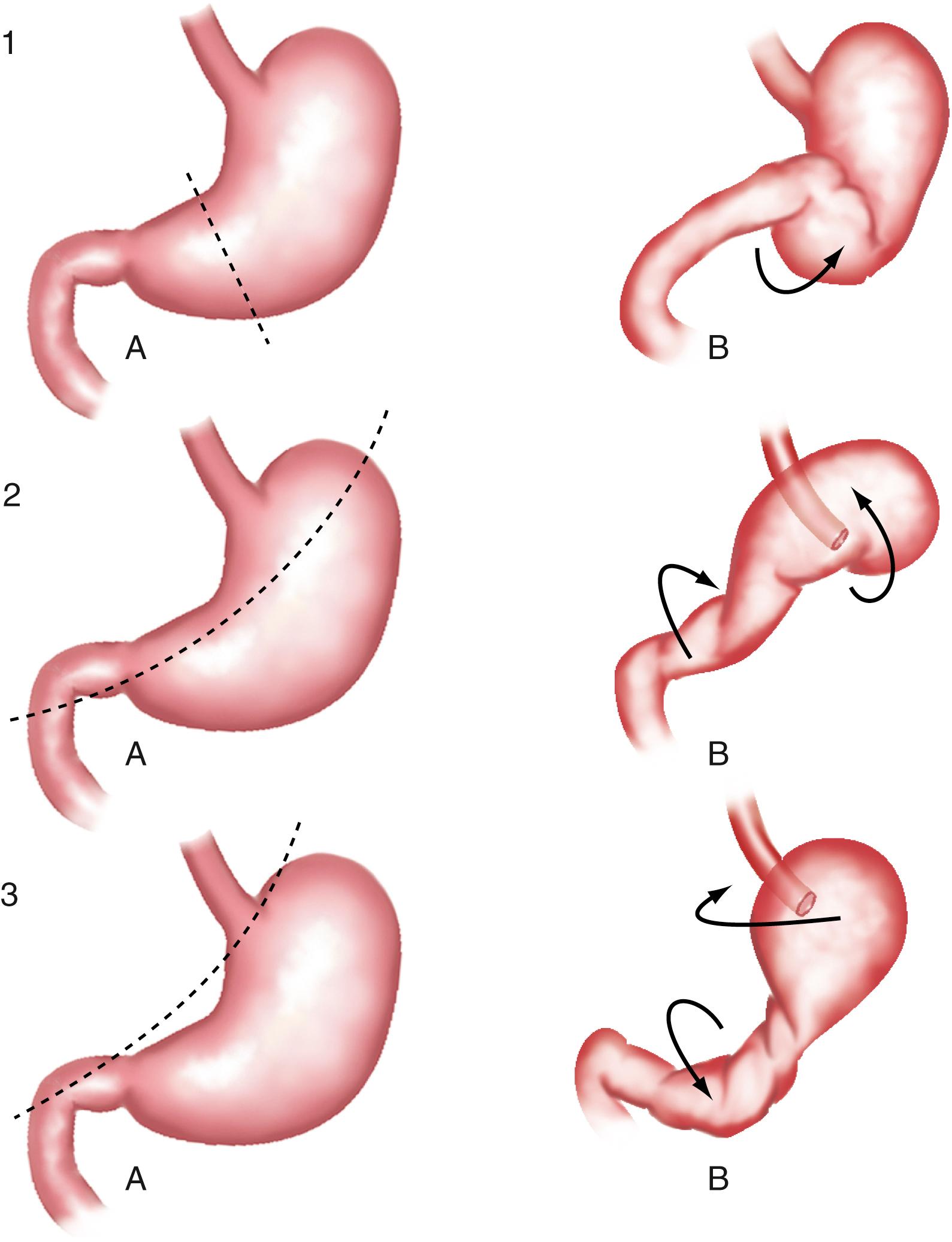
The incidence and prevalence of gastric volvulus are unknown. It is difficult to estimate how many cases are intermittent and undiagnosed. About 15% to 20% of cases occur in children younger than 1 year of age, most often in association with a congenital diaphragmatic defect. The peak incidence in adults is in the fifth decade. Men and women are equally affected.
Acute gastric volvulus causes sudden severe pain in the upper abdomen or lower chest, associated with the inability to swallow. Persistent unproductive retching is common. In cases of complete volvulus, it is impossible to pass a nasogastric tube into the stomach. Hematemesis is rare but may be due to an esophageal tear or gastric mucosal ischemia. Vascular compromise and gastric infarction may occur. The combination of pain, unproductive retching, and inability to pass a nasogastric tube is called Borchardt triad . If the volvulus is associated with a diaphragmatic hernia, plain chest or abdominal films will show a large gas-filled structure in the chest. CT is often obtained in the emergency department and will show the stomach in the chest. A barium UGI radiograph will confirm the diagnosis but is often unnecessary in the case of the classic triad and diagnostic CT. Upper endoscopy may show twisting of the gastric folds ( Fig. 27.6C ). Acute gastric volvulus is a surgical emergency. The surgeon must have a low threshold for making this diagnosis in a patient that presents with this symptom complex. Delay in surgery can result in gastric necrosis, which has a high mortality.

Chronic gastric volvulus is associated with mild and nonspecific symptoms like dysphagia, epigastric discomfort or fullness, bloating, and heartburn, particularly after meals. Symptoms may be intermittent and present for months to years. A substantial number of cases likely go unrecognized. The diagnosis should be suspected in the proper clinical setting if a UGI radiograph or CT shows a large diaphragmatic hernia, even if the stomach is not twisted at the time of the radiograph.
Become a Clinical Tree membership for Full access and enjoy Unlimited articles
If you are a member. Log in here